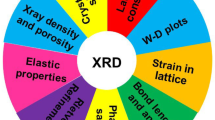Abstract
Magnetic nanoparticles have found broad applications in medicine, especially for cell targeting and transport, and as contrast agents in MRI. Our samples of 𝜖-Fe2O3 nanoparticles were prepared by annealing in silica matrix, which was leached off and the bare particles were then coated with amorphous silica layers of various thicknesses. The distribution of particle sizes was determined from the TEM pictures giving the average size ∼20 nm and the thickness of silica coating ∼5; 8; 12; 19 nm. The particles were further characterized by the XRPD and DC magnetic measurements. The nanoparticles consisted mainly of 𝜖-Fe2O3 with admixtures of ∼1 % of the α phase and less than 1 % of the γ phase. The hysteresis loops displayed coercivities of ∼2 T at room temperature. The parameters of hyperfine interactions were derived from transmission Mössbauer spectra. Observed differences of hyperfine fields for nanoparticles in the matrix and the bare ones are ascribed to strains produced during cooling of the composite. This interpretation is supported by slight changes of their lattice parameters and increase of the elementary cell volume deduced from XRD. The temperature dependence of the magnetization indicated a two-step magnetic transition of the 𝜖-Fe2O3 nanoparticles spread between ∼85 K and ∼150 K, which is slightly modified by remanent tensile stresses in the case of nanoparticles in the matrix. The subsequent coating of the bare particles by silica produced no further change in hyperfine parameters, which indicates that this procedure does not modify magnetic properties of nanoparticles.
Similar content being viewed by others
References
Laurent, S., Forge, D., Port, M., Roch, A., Robic, C., Elst, L.V., Muller, R.N.: Magnetic iron oxide nanoparticles: synthesis, stabilization, vectorization, physicochemical characterizations, and biological applications (vol 108, pg 2064, 2008). Chem. Rev. 110(4), 2574 (2010). doi:10.1021/Cr900197g
Liu, G., Gao, J., Ai, H., Chen, X.: Applications and potential toxicity of magnetic iron oxide nanoparticles. Small 9(9–10), 1533–1545 (2013). doi:10.1002/smll.201201531
Sun, C., Lee, J.S.H., Zhang, M.: Magnetic nanoparticles in MR imaging and drug delivery. Adv. Drug Deliv. Rev. 60(11), 1252–1265 (2008). doi:10.1016/j.addr.2008.03.018
Tartaj, P., Morales, M.a.d.P., Veintemillas-Verdaguer, S., Gonz lez Carre o, T., Serna, C.J.: The preparation of magnetic nanoparticles for applications in biomedicine. J. Phys. D: Appl. Phys. 36(13), R182–R197 (2003). doi:10.1088/0022-3727/36/13/202
Tseng, Y.C., Souza-Neto, N.M., Haskel, D., Gich, M., Frontera, C., Roig, A., Van Veenendaal, M., Nogués, J.: Nonzero orbital moment in high coercivity 𝜖-Fe 2O3 and low-temperature collapse of the magnetocrystalline anisotropy. Phys. Rev. B - Condens. Matter Mater. Phys. 79 (9), 1–6 (2009). doi:10.1103/PhysRevB.79.094404
Gich, M., Fina, I., Morelli, A., Sánchez, F., Alexe, M., Gázquez, J., Fontcuberta, J., Roig, A.: Multiferroic Iron oxide thin films at room temperature. Adv. Mater. (Deerfield Beach Fla.) 3(111), 4645–4652 (2014). doi:10.1002/adma.201400990. http://www.ncbi.nlm.nih.gov/pubmed/24831036
Tronc, E., Chanéac, C., Jolivet, J.: Structural and magnetic characterization of 𝜖-Fe 2O3. J. Solid State Chem. 139(1), 93–104 (1998). doi:10.1088/0953-8984/23/12/126003. http://www.sciencedirect.com/science/article/pii/S0022459698978173
Sakurai, S., Jin, J., Hashimoto, K., Ohkoshi, S.I.: Reorientation phenomenon in a magnetic phase of 𝜖-Fe 2O3 Nanocrystal. J. Phys. Soc. Japan 74 (7), 1946–1949 (2005). doi:10.1143/JPSJ.74.1946
Taboada, E., Gich, M., Roig, A.: Nanospheres of silica with an 𝜖-Fe 2O3 single crystal nucleus. ACS Nano 3 (11), 3377–3382 (2009). doi:10.1021/nn901022s
Kohout, J., Brázda, P., Závěta, K., Kubániová, D., Kmječ, T., Kubíčková, L., Klementová, M., Šantavá, E., Lančok, A.: The magnetic transition in 𝜖-Fe 2O3 nanoparticles: Magnetic properties and hyperfine interactions from Mössbauer spectroscopy. J. Appl. Phys. 117(17), 17D505 (2015). doi:10.1063/1.4907610. http://scitation.aip.org/content/aip/journal/jap/117/17/10.1063/1.4907610
Tuček, J., Zbořil, R., Namai, A., Ohkoshi, S.I.: 𝜖-Fe 2O3: An advanced nanomaterial exhibiting giant coercive field, millimeter-wave ferromagnetic resonance, and magnetoelectric coupling. Chem. Mater. 22(24), 6483–6505 (2010). doi:10.1021/cm101967h
Brázda, P., Kohout, J., Bezdička, P., Kmječ, T.: α-Fe 2O3 versus β-Fe 2O3: Controlling the phase of the transformation product of 𝜖-Fe 2O3 in the Fe 2O3/SiO 2 system. Cryst. Growth Des. 14(3), 1039–1046 (2014). doi:10.1021/cg4015114
Stöber, W., Fink, A., Bohn, E.: Controlled growth of monodisperse silica spheres in the micron size range. J. Colloid Interf. Sci. 26(1), 62–69 (1968). doi:10.1016/0021-9797(68)90272-5
Roisnel, T., Rodri̇quez-Carvajal, J.: WinPLOTR: A windows tool for powder diffraction pattern analysis. Mater. Sci. Forum 378–381, 118–123 (2001)
Gich, M., Frontera, C., Roig, A., Taboada, E., Molins, E., Rechenberg, H.R., Ardisson, J.D., Macedo, W.A.A., Ritter, C., Hardy, V., Sort, J., Skumryev, V., Nogues, J.: High and low-temperature crystal and magnetic structures of 𝜖-Fe 2O3 and their correlation to its magnetic properties. Chem. Mater. 18, 3889–3897 (2006). doi:10.1021/cm0609931. cond-mat/0604677
Machala, L., Tuček, J., Zbořil, R.: Polymorphous transformations of nanometric iron(III) oxide: A review. Chem. Mater. 23(14), 3255–3272 (2011)
žák, T., Jirásková, Y.: CONFIT: Mössbauer spectra fitting program. Surf. Interf. Anal. 38, 710–714 (2006). doi:10.1002/sia2285
Kiss, L.B., Söderlund, J., Niklasson, G.A., Granqvist, C.G.: New approach to the origin of lognormal size distributions of nanoparticles. Nanotechnology 1, 25–28. doi:10.1088/0957-4484/10/1/006. http://stacks.iop.org/0957-4484/10/ i=1/a=006?key=crossref.1abef74d8eebae4f850c722f3127f402 http://iopscience.iop.org/0957-4484/10/1/006
Bødker, F., Mørup, S., Linderoth, S.: Surface effects in metallic iron nanoparticles. Phys. Rev. Lett. 72(2), 282–285 (1994). doi:10.1103/PhysRevLett.72.282
Coey, J.M.D.: Noncollinear spin arrangement in ultrafine ferrimagnetic crystallites. Phys. Rev. Lett. 27(17), 1140–1142 (1971)
Author information
Authors and Affiliations
Corresponding author
Additional information
This article is part of the Topical Collection on Proceedings of the International Conference on Hyperfine Interactions and their Applications (HYPERFINE 2016), Leuven, Belgium, 3-8 July 2016
Edited by Kristiaan Temst, Stefaan Cottenier, Lino M. C. Pereira and André Vantomme
Rights and permissions
About this article
Cite this article
Kubíčková, L., Kohout, J., Brázda, P. et al. Impact of silica environment on hyperfine interactions in 𝜖-Fe2O3 nanoparticles. Hyperfine Interact 237, 159 (2016). https://doi.org/10.1007/s10751-016-1356-8
Published:
DOI: https://doi.org/10.1007/s10751-016-1356-8




